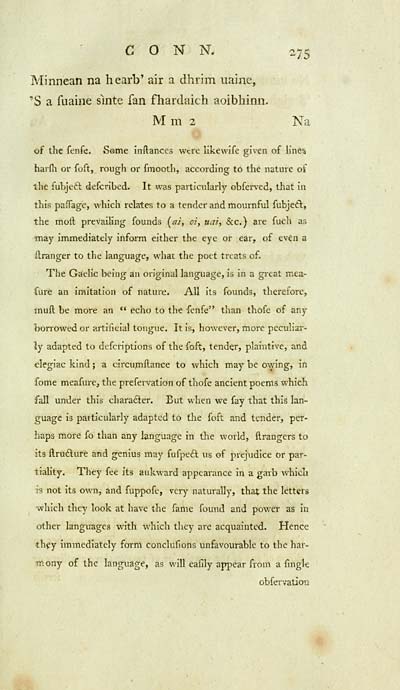Ossian Collection > Sean dana
(287)
Download files
Complete book:
Individual page:
Thumbnail gallery: Grid view | List view

CONN. 275
Minnean na hearb' air a dhrim uainc,
'S a fuaine sinte fan fhardaich aoibhinn.
M m 2 Na
of the fenfe. Some inflances were likewife given of lines
harfli or foft, rough or fmooth, according to the nature of
the fubjeel defcribed. It was particularly obferved, that in
this paflage, which relates to a tender and mournful fubjeci,
the moil prevailing founds (a/, oi, uai, &c.) are fuch as
may immediately inform either the eye or ear, of even a
ilranger to the language, what the poet treats of.
The Gaelic being an original language, is in a great mea-
sure an imitation of nature. All its founds, therefore,
mull be more an " echo to the fenfe" than thofe of any
borrowed or artificial tongue. It is, however, more peculiar-
ly adapted to defcriptions of the foft, tender, plaintive, and
elegiac kind ; a circumftance to which may be owing, in
fome meafure, the prefervation of thofe ancient poems which
fall under this character. But when we fay that this lan-
guage is particularly adapted to the foft and tender, per-
haps more fo than any language in the world, ftrangers to
its ftrudture and genius may fufpeft us of prejudice or par-
tiality. They fee its aukward appearance in a garb which
is not its own, and fuppofe, very naturally, that the letters
which they look at have the fame found and power as in
other languages with which they are acquainted. Hence
they immediately form conclufions unfavourable to the har-
mony of the language, as will eafily appear from a fingk
observation
Minnean na hearb' air a dhrim uainc,
'S a fuaine sinte fan fhardaich aoibhinn.
M m 2 Na
of the fenfe. Some inflances were likewife given of lines
harfli or foft, rough or fmooth, according to the nature of
the fubjeel defcribed. It was particularly obferved, that in
this paflage, which relates to a tender and mournful fubjeci,
the moil prevailing founds (a/, oi, uai, &c.) are fuch as
may immediately inform either the eye or ear, of even a
ilranger to the language, what the poet treats of.
The Gaelic being an original language, is in a great mea-
sure an imitation of nature. All its founds, therefore,
mull be more an " echo to the fenfe" than thofe of any
borrowed or artificial tongue. It is, however, more peculiar-
ly adapted to defcriptions of the foft, tender, plaintive, and
elegiac kind ; a circumftance to which may be owing, in
fome meafure, the prefervation of thofe ancient poems which
fall under this character. But when we fay that this lan-
guage is particularly adapted to the foft and tender, per-
haps more fo than any language in the world, ftrangers to
its ftrudture and genius may fufpeft us of prejudice or par-
tiality. They fee its aukward appearance in a garb which
is not its own, and fuppofe, very naturally, that the letters
which they look at have the fame found and power as in
other languages with which they are acquainted. Hence
they immediately form conclufions unfavourable to the har-
mony of the language, as will eafily appear from a fingk
observation
Set display mode to: Large image | Transcription
Images and transcriptions on this page, including medium image downloads, may be used under the Creative Commons Attribution 4.0 International Licence unless otherwise stated. ![]()
| Early Gaelic Book Collections > Ossian Collection > Sean dana > (287) |
|---|
| Permanent URL | https://digital.nls.uk/77331752 |
|---|
| Description | Selected books from the Ossian Collection of 327 volumes, originally assembled by J. Norman Methven of Perth. Different editions and translations of James MacPherson's epic poem 'Ossian', some with a map of the 'Kingdom of Connor'. Also secondary material relating to Ossianic poetry and the Ossian controversy. |
|---|
| Description | Selected items from five 'Special and Named Printed Collections'. Includes books in Gaelic and other Celtic languages, works about the Gaels, their languages, literature, culture and history. |
|---|

